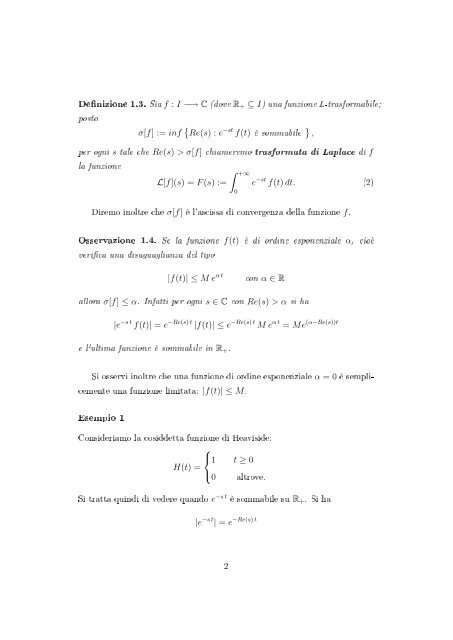1 La trasformata di Laplace
1 La trasformata di Laplace
1 La trasformata di Laplace
- No tags were found...
Create successful ePaper yourself
Turn your PDF publications into a flip-book with our unique Google optimized e-Paper software.
Denizione 1.3. Sia f : I −→ C (dove R + ⊆ I) una funzione L-trasformabile;postoσ[f] := inf { Re(s) : e −st f(t) è sommabile } ,per ogni s tale che Re(s) > σ[f] chiameremo <strong>trasformata</strong> <strong>di</strong> <strong>La</strong>place <strong>di</strong> fla funzioneL[f](s) = F (s) :=∫ +∞0e −st f(t) dt. (2)Diremo inoltre che σ[f] è l'ascissa <strong>di</strong> convergenza della funzione f.Osservazione 1.4. Se la funzione f(t) è <strong>di</strong> or<strong>di</strong>ne esponenziale α, cioèverica una <strong>di</strong>suguaglianza del tipo|f(t)| ≤ M e α tcon α ∈ Rallora σ[f] ≤ α. Infatti per ogni s ∈ C con Re(s) > α si ha|e −s t f(t)| = e −Re(s) t |f(t)| ≤ e −Re(s) t M e α t = Me (α−Re(s))te l'ultima funzione è sommabile in R + .Si osservi inoltre che una funzione <strong>di</strong> or<strong>di</strong>ne esponenziale α = 0 è semplicementeuna funzione limitata: |f(t)| ≤ M.Esempio 1Consideriamo la cosiddetta funzione <strong>di</strong> Heaviside:⎧⎨1 t ≥ 0H(t) =⎩0 altrove.Si tratta quin<strong>di</strong> <strong>di</strong> vedere quando e −s t è sommabile su R + . Si ha|e −s t | = e −Re(s) t2
















